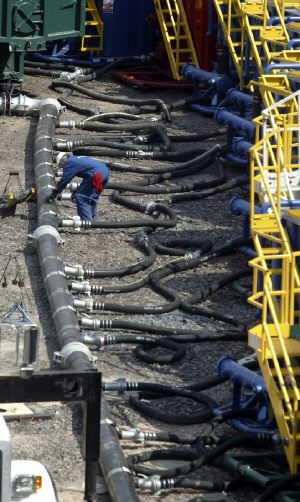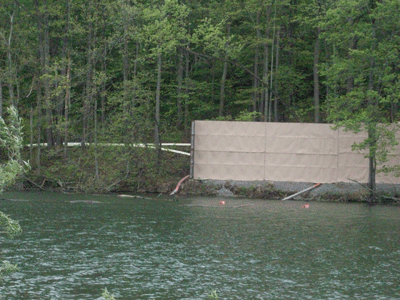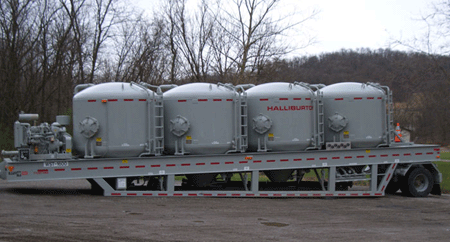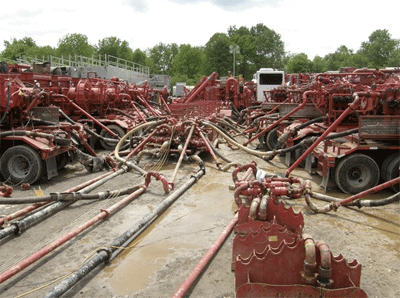Hydro-fracturing
From Wikimarcellus
| Revision as of 15:43, 26 September 2009 Tcopley (Talk | contribs) ← Previous diff |
Current revision Tcopley (Talk | contribs) (→Technologies - add link for drilling fluids) |
||
| Line 1: | Line 1: | ||
| - | '''Hydro-fracturing''', (aka Hydraulic fracturing) or ''fracing'' for short, is the process of injecting water, sand, diesel fuel, and/or a cocktail of chemicals into a well, under high pressure, in order to fracture the shale thereby releasing methane gas trapped in the pores of the rock so it can flow up the pipe. It is a time tested procedure for stimulating a well’s productivity that has been used in oil and gas drilling since the 1940's. | + | [[Image:Frac.jpg|frame|right|<div align="center">'''Worker adjusting water line used in hydro-fracturing a Marcellus well in Dimock Township, Susquehanna County, PA'''. Courtesy of Michael J. Mullen, Staff Photographer, <br>[http://www.thetimes-tribune.com/ ''Scranton Times-Tribune'']</div>]] |
| + | '''Hydro-fracturing''', (aka Hydraulic fracturing) or ''fracing'' for short, is the most often used method of increasing the productivity of oil and natural gas wells. It is the process of increasing the flow of gas from a well by injecting a slurry of water, sand, and chemicals into it under high pressure, generally 5-7,000 pounds per square inch, in order to create a ''long fracture sand pack'' intersecting with natural fractures in the shale thereby creating a flow channel network to the wellbore. Fracing releases the methane gas trapped in the natural fractures or pores of the shale so it can flow up the pipe. The mixture injected is called [[Drilling fluid|fracing fluid]]. | ||
| - | Hydro-fracturing may be accompanied by [[acid fracturing]] and the use of [[proppants]]. Also [[crosslinked guar gel]] is sometimes used. Generally, drilling industry purveyors consider the exact recipes they use for preparing drilling fluids to be their trade secrets. This includes the [[chemicals]] involved. Several of these are believed to be toxic. | + | ===The Process=== |
| + | [[Marcellus shale]] fracing normally takes place 7,000 to 10,000 feet underground, more than a mile of solid rock below the water table. Fracing is a time tested procedure for stimulating a well’s productivity that has been in use in oil and gas drilling since the late 1940's. The fracturing process works on the principle of building pressure until the rock fractures, and then the pressure is removed. At one mile below the surface, the weight of the rock itself generates at least 7,000 pounds per square inch. | ||
| - | <center>http://www.sonic.net/~tcopley/img/frac.jpg <br>'''Worker adjusting water line used in hydro-fracturing'''<br> a Marcellus well in Dimock Township, Susquehanna County, PA<br>Courtesy of Michael J. Mullen, Staff Photographer, <br>''Scranton Times-Tribune''[http://www.thetimes-tribune.com/]</center> | + | [[Proppants|Proppant]] is a granular-like material that can be suspended and transported in fracturing fluid that is pumped down a well. It fills up the fractures and props them open after high-pressure pumping concludes. Fractures filled with proppant make an effective flow channel network for natural gas to flow more freely from the shale formation into a well bore. |
| - | While the hydro-fracturing process can use millions of gallons of water for a well, typically a well uses around 750,000 gallons. It generates similar quantities of [[waste water]]. The fluid that comes back up after fracturing a shale well is called [[flowback water]]. It includes all of the chemicals pumped in plus both non-toxic and toxic substances that [[Produced water|may be present]] in the shale formation. Water usually must be trucked into and out of a well site. One approach that can be used to minimize the amount of polluted water trucked out is a [[closed loop system]]. | + | Fractures created by hydro-fracturing are small ones, usually less than an eighth of an inch or less wide, and never propagate over long distances. They end thousands a feet below the surface drinking water aquifers and can't act as conduit for formation water or natural gas to penetrate to the level of ground water. Typically, fracing opens up fractures no more than 1,000 to 1,500 feet from the well bore, and proppant travels approximately 300 to 500 feet. Beyond the range that proppant travels, fractures tend to close up once pressure from the fracturing is removed. The weight of the earth at depth exerts enough pressure to close up at least half the fractures. |
| + | |||
| + | Assuming the well is properly cemented and cased, the wellbore is the only way for natural gas and [[flowback water]] to escape the formation up to the surface where it can be properly managed. | ||
| + | |||
| + | Fracing fluid is pumped in through a network of pipes and equipment that is both highly automated as well as closely watched during all stages of the fracing process. An operator regularly makes fine-tuning adjustments while the procedure is underway in order to optimize gas production. | ||
| + | |||
| + | ===Phases of Hydro-fracturing=== | ||
| + | There are a number of phases to hydro-fracturing a well. One of these consists in perforating the pipe sent down a well so that it can receive the fracing fluid, that is, the water and sand in highly pressurized slurry form, and allow it to be injected into the shale formation. | ||
| + | |||
| + | [[Horizontal drilling|Horizontal]] Marcellus shale wells typically use ''multi-stage fracturing''. This method positions fractures in predetermined locations along the wellbore in order to increase production. Stages generally average 300 feet in length, so a well with a 3,000 foot lateral could have 3,000 divided by 300, or up to as many as 10 stages. | ||
| + | |||
| + | ===Fracturing Fluid=== | ||
| + | Hydro-fracturing may be accompanied by [[acid fracturing]] and the use of proppant. Also [[crosslinked guar gel]] is sometimes used. Generally, field service companies consider the exact recipes they use for preparing [[fracturing fluid]] to be trade secrets. This includes the [[chemicals]] involved to reduce corrosion, retard bacterial growth and improve down-hole lubrication. Some of these are believed to be toxic, yet the chemicals are only used in very dilute quantities. Ususally 99.5% of fracing fluid consists of nothing more than water and sand. | ||
| One method of hydro-fracturing is called [[slickwater]]. | One method of hydro-fracturing is called [[slickwater]]. | ||
| - | <center>http://www.sonic.net/~tcopley/img/halliburton_skid_sm.gif <br>'''[[Halliburton]] frac fluid trailer'''<br> left along side highway near the Borough<br>of Houston, Washington County, PA<br>[http://donnan.com/ Photo credit - donnan.com]</center> | + | [[Image:Franklin-Lake3.gif|frame|left|<div align="center">'''Fresh water being withdrawn from small lake in Washington Co., PA to fracture well. White pipes emerging from behind blind lead to a staging area 2 mi. away.''' Photo credit - [http://www.gomarcellusshale.com/profile/JosephineSabillon Josephine Sabillon]</div>]] |
| + | While the hydro-fracturing process can use millions of gallons of water for a well, typically a vertical well only uses around 750,000 gallons. A [[Horizontal drilling|horizontal]] well with a 4,500 foot lateral averages between 4 to 5 million gallons of water. | ||
| - | Many environmentalists have raised [[Environmental concerns|concerns]] about the process of hydro-fracturing shale wells as a potential source of toxic contamination of the water supply. Polluted water has also occasionally leaked from plastic-lined wastewater containment pits. Marcellus shale drilling is more or less still in its infancy compared to drilling in other North American shales. To date there have been very few Marcellus water contamination issues with notable exceptions of [[Cabot_Oil_and_Gas_Corp#The_challenges_at_Dimock|Dimock]] and [[Range_Resources#Cross_Creek_Park_contamination_issues|Cross Creek Park]]. | + | ===Waste Water=== |
| + | Hydro-fracturing generates quantities of [[waste water]] that are of the a similar order of magnitude as the water pumped into the shale formation. The fluid that comes back up after fracturing a shale well is called [[flowback water]]. It includes all of the chemicals pumped in plus both non-toxic and toxic substances that [[Produced water|may be present]] in the shale formation. Water usually must be trucked into and out of a well site. | ||
| - | Protecting groundwater is considered by all responsible drillers to be part of their job. Carefully engineered well casings made from steel and special concrete maintain an effective barrier between the well bore and surrounding groundwater as it passes through. Hydro-fracturing takes place thousands of feet below the water table, so leakage of any contaminated water would certainly seem to be quite uncommon, if not the rare exception. | ||
| + | ====Technologies==== | ||
| + | [[Image:Halliburton skid sm.gif|frame|right|<div align="center">'''[[Halliburton]] fluids trailer left along side highway near the Borough<br>of Houston, Washington County, PA''' [http://donnan.com/ Photo credit - donnan.com]</div>]] | ||
| + | An approach that can be used to minimize the amount of polluted water trucked out is a [[closed loop system]]. A promising new way of hydro-fracturing gas wells, first introduced in Marcellus shale drilling in September, 2009, is the use of [[GASFRAC Energy Services Inc|Liquefied Petroleum Gas (LPG)]] (propane) in gel form. Using this process there is ''no'' flowback water since LPG is used as the fracturing agent and to transport the proppants into the fractures, and all of the LPG is recaptured back up the well. | ||
| + | |||
| + | As of January, 2011, some of the oilfield service companies began introducing lines of biodegradable, non-toxic [[chemicals]] to use in hydro-fracturing. | ||
| + | |||
| + | Another new development on the horizon is using [[nanotechnology]] in [[drilling fluids]]. | ||
| + | |||
| + | ===Environmental Concerns=== | ||
| + | Many environmentalists have raised [[Environmental concerns|concerns]] about the process of hydro-fracturing shale wells as a potential source of toxic contamination of the water supply. Polluted water has also occasionally leaked from plastic-lined wastewater containment pits or impoundments. Marcellus shale drilling is more or less still in its infancy compared to drilling in other North American shales. To date there have been very few Marcellus water contamination issues with notable exceptions of [[Cabot_Oil_and_Gas_Corp#The_challenges_at_Dimock|Dimock]] and [[Range_Resources#Cross_Creek_Park_contamination_issues|Cross Creek Park]]. Neither of these were examples of drinking water contamination caused by hydro-fracturing gas wells, but rather resulted from some other issues and were subsequently remedied. | ||
| + | ====Groundwater the Driller's Responsibility==== | ||
| + | Protecting groundwater is considered by all responsible drillers to be part of their job. Carefully engineered well casings made from multiple layers of steel and special concrete encase the well and maintain an effective barrier between the well bore and surrounding groundwater as it passes through. The casing is run well below the water table to secure against any leakage. Hydro-fracturing takes place thousands of feet below the water table, so the infusion of any contaminated water into the groundwater above would certainly seem to be a very unlikely scenario, if not the rare exception. | ||
| + | |||
| + | [[Image:Missle.gif|frame|center|<div align="center">'''Pump Trucks and “Missile” on Frac Job In Greene Co., PA'''<br>[http://www.energycorporationofamerica.com/ Photo courtesy of Energy Corp. of America]</div>]] | ||
| + | |||
| + | ====Not Only Groundwater at Stake==== | ||
| The process uses anywhere from 750,000 gallons of water on up to millions of gallons per well which usually must be trucked into drilling sites. The tanker trucks used to bring water in and diesel engines used to power drilling and pumping equipment on the drill site are recognized as a sources of air pollution. There are also concerns about [[noise-control]] issues. These relate not only to noise from drilling and pumping equipment, but also from gas compressors which run continuously once the well is actually producing gas. | The process uses anywhere from 750,000 gallons of water on up to millions of gallons per well which usually must be trucked into drilling sites. The tanker trucks used to bring water in and diesel engines used to power drilling and pumping equipment on the drill site are recognized as a sources of air pollution. There are also concerns about [[noise-control]] issues. These relate not only to noise from drilling and pumping equipment, but also from gas compressors which run continuously once the well is actually producing gas. | ||
| + | |||
| + | Another environmental issue indirectly tied to hydro-fracturing is the invasion of forests by [[non-native plants]]. | ||
| === Resources === | === Resources === | ||
| Pennsylvania Department of Environmental Protection, Summary of Hydraulic Fracture Solutions-(PDF Format) [http://www.dep.state.pa.us/dep/deputate/minres/oilgas/FractListing.pdf] | Pennsylvania Department of Environmental Protection, Summary of Hydraulic Fracture Solutions-(PDF Format) [http://www.dep.state.pa.us/dep/deputate/minres/oilgas/FractListing.pdf] | ||
| + | |||
| + | |||
| + | [[Category:drilling practices]] | ||
Current revision

Scranton Times-Tribune
Hydro-fracturing, (aka Hydraulic fracturing) or fracing for short, is the most often used method of increasing the productivity of oil and natural gas wells. It is the process of increasing the flow of gas from a well by injecting a slurry of water, sand, and chemicals into it under high pressure, generally 5-7,000 pounds per square inch, in order to create a long fracture sand pack intersecting with natural fractures in the shale thereby creating a flow channel network to the wellbore. Fracing releases the methane gas trapped in the natural fractures or pores of the shale so it can flow up the pipe. The mixture injected is called fracing fluid.
Contents |
The Process
Marcellus shale fracing normally takes place 7,000 to 10,000 feet underground, more than a mile of solid rock below the water table. Fracing is a time tested procedure for stimulating a well’s productivity that has been in use in oil and gas drilling since the late 1940's. The fracturing process works on the principle of building pressure until the rock fractures, and then the pressure is removed. At one mile below the surface, the weight of the rock itself generates at least 7,000 pounds per square inch.
Proppant is a granular-like material that can be suspended and transported in fracturing fluid that is pumped down a well. It fills up the fractures and props them open after high-pressure pumping concludes. Fractures filled with proppant make an effective flow channel network for natural gas to flow more freely from the shale formation into a well bore.
Fractures created by hydro-fracturing are small ones, usually less than an eighth of an inch or less wide, and never propagate over long distances. They end thousands a feet below the surface drinking water aquifers and can't act as conduit for formation water or natural gas to penetrate to the level of ground water. Typically, fracing opens up fractures no more than 1,000 to 1,500 feet from the well bore, and proppant travels approximately 300 to 500 feet. Beyond the range that proppant travels, fractures tend to close up once pressure from the fracturing is removed. The weight of the earth at depth exerts enough pressure to close up at least half the fractures.
Assuming the well is properly cemented and cased, the wellbore is the only way for natural gas and flowback water to escape the formation up to the surface where it can be properly managed.
Fracing fluid is pumped in through a network of pipes and equipment that is both highly automated as well as closely watched during all stages of the fracing process. An operator regularly makes fine-tuning adjustments while the procedure is underway in order to optimize gas production.
Phases of Hydro-fracturing
There are a number of phases to hydro-fracturing a well. One of these consists in perforating the pipe sent down a well so that it can receive the fracing fluid, that is, the water and sand in highly pressurized slurry form, and allow it to be injected into the shale formation.
Horizontal Marcellus shale wells typically use multi-stage fracturing. This method positions fractures in predetermined locations along the wellbore in order to increase production. Stages generally average 300 feet in length, so a well with a 3,000 foot lateral could have 3,000 divided by 300, or up to as many as 10 stages.
Fracturing Fluid
Hydro-fracturing may be accompanied by acid fracturing and the use of proppant. Also crosslinked guar gel is sometimes used. Generally, field service companies consider the exact recipes they use for preparing fracturing fluid to be trade secrets. This includes the chemicals involved to reduce corrosion, retard bacterial growth and improve down-hole lubrication. Some of these are believed to be toxic, yet the chemicals are only used in very dilute quantities. Ususally 99.5% of fracing fluid consists of nothing more than water and sand.
One method of hydro-fracturing is called slickwater.

While the hydro-fracturing process can use millions of gallons of water for a well, typically a vertical well only uses around 750,000 gallons. A horizontal well with a 4,500 foot lateral averages between 4 to 5 million gallons of water.
Waste Water
Hydro-fracturing generates quantities of waste water that are of the a similar order of magnitude as the water pumped into the shale formation. The fluid that comes back up after fracturing a shale well is called flowback water. It includes all of the chemicals pumped in plus both non-toxic and toxic substances that may be present in the shale formation. Water usually must be trucked into and out of a well site.
Technologies

of Houston, Washington County, PA Photo credit - donnan.com
An approach that can be used to minimize the amount of polluted water trucked out is a closed loop system. A promising new way of hydro-fracturing gas wells, first introduced in Marcellus shale drilling in September, 2009, is the use of Liquefied Petroleum Gas (LPG) (propane) in gel form. Using this process there is no flowback water since LPG is used as the fracturing agent and to transport the proppants into the fractures, and all of the LPG is recaptured back up the well.
As of January, 2011, some of the oilfield service companies began introducing lines of biodegradable, non-toxic chemicals to use in hydro-fracturing.
Another new development on the horizon is using nanotechnology in drilling fluids.
Environmental Concerns
Many environmentalists have raised concerns about the process of hydro-fracturing shale wells as a potential source of toxic contamination of the water supply. Polluted water has also occasionally leaked from plastic-lined wastewater containment pits or impoundments. Marcellus shale drilling is more or less still in its infancy compared to drilling in other North American shales. To date there have been very few Marcellus water contamination issues with notable exceptions of Dimock and Cross Creek Park. Neither of these were examples of drinking water contamination caused by hydro-fracturing gas wells, but rather resulted from some other issues and were subsequently remedied.
Groundwater the Driller's Responsibility
Protecting groundwater is considered by all responsible drillers to be part of their job. Carefully engineered well casings made from multiple layers of steel and special concrete encase the well and maintain an effective barrier between the well bore and surrounding groundwater as it passes through. The casing is run well below the water table to secure against any leakage. Hydro-fracturing takes place thousands of feet below the water table, so the infusion of any contaminated water into the groundwater above would certainly seem to be a very unlikely scenario, if not the rare exception.

Photo courtesy of Energy Corp. of America
Not Only Groundwater at Stake
The process uses anywhere from 750,000 gallons of water on up to millions of gallons per well which usually must be trucked into drilling sites. The tanker trucks used to bring water in and diesel engines used to power drilling and pumping equipment on the drill site are recognized as a sources of air pollution. There are also concerns about noise-control issues. These relate not only to noise from drilling and pumping equipment, but also from gas compressors which run continuously once the well is actually producing gas.
Another environmental issue indirectly tied to hydro-fracturing is the invasion of forests by non-native plants.
Resources
Pennsylvania Department of Environmental Protection, Summary of Hydraulic Fracture Solutions-(PDF Format) [1]

